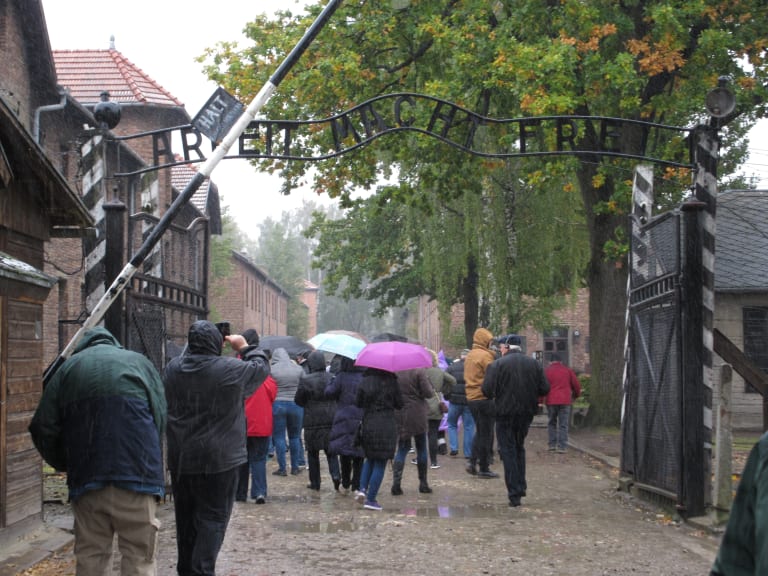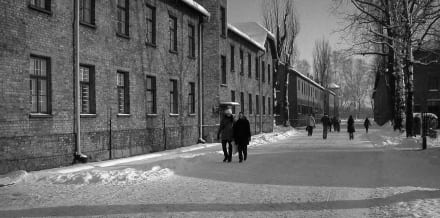More about: Things to Do in Auschwitz
If you are organising a visit to Auschwitz, there are two ways to visit: either on your own, by buying tickets, or by joining one of the Auschwitz tours from Kraków. I personally recommend the second option as, in addition to not having to worry about the logistics of getting there, you'll be accompanied by an expert guide who will help you understand this tragic episode in history.
During your visit, you'll see the two main camps: Auschwitz I and Auschwitz II, separated by only 3 kilometres. Here is a list of what you will see during the tour.
Auschwitz I Camp

This is the entrance to the extermination camp and the original part of the Auschwitz-Birkenau complex and is, of course, included if you book a tour to Auschwitz. It was built in 1940 by the Nazis with the idea of holding between 15,000 and 20,000 prisoners.
The tour of Auschwitz starts here, where the visitor centre is located. You will immediately recognise the iron gate that appears in all the photos, headed by the famous writing "Work will set you free".
The short documentary of the visitor centre

Booking a tour to Auschwitz includes a visit to the Auschwitz Visitor Centre at the beginning of the tour, which offers a short documentary (about 15 minutes) to help you contextualise what you will see next.
In my opinion, it is well worth the time (especially if you have not hired a guide or audio guide for the visit) because it is very dynamic and everything is very well explained. The documentary is in black and white and shows original images from the time.
The large barracks with artefacts and photos of the victims

The first thing that will strike you as you enter the area are the huge brick barracks where the Jews arrived and where they were housed during their stay in the camp.
Some of them have now been converted into a museum, where some of the prisoners' belongings that were recovered after the liberation of the camp are on display. You will see small objects of personal hygiene, clothes, shoes, suitcases... In this part, the tension of the visit starts to rise and get tougher.
The exhibits inside the barracks
Along some of the corridors you will also see endless walls filled with pictures of the Jews whose lives ended in Auschwitz. On them, you will see the date of their arrival at the camp and their date of extermination. While those who arrived during the first few months spent a long time working there until they were exterminated, those who arrived last barely lasted weeks or months before their lives ended.
If you book the Auschwitz tour with children, my advice is not to dwell too long on this part of the exhibition, as the details can be very upsetting (there is even a large room with the hair that was shaved off the prisoners on arrival).
The old railway tracks

Along one side of the camp and also linking the first and the second, you will see abandoned railway tracks. These tracks were used to transport prisoners from one camp to another or to receive them from different parts of the country and the rest of Europe.
If you book the Auschwitz tour, please note that the guide will give you a background on how these transfers were carried out and how the prisoners were crammed into overcrowded wagons. Today these train tracks are no longer used for anything, but are maintained as part of the Auschwitz memorial.
The great Auschwitz II open fields

After an emotionally charged visit to Auschwitz I, it is time to move on to Auschwitz II. If you book the Auschwitz tour and go to this part of the camp, you will find that it is much less touristy and less visited than Auschwitz I. And, because it is so large, it is also much less crowded than Auschwitz II. Moreover, because it is so large and has so few barracks still standing, it will give you a much greater sense of coldness and abandonment.
This camp was built by the Nazis as an extension of the first camp. The number of Jews that could be held here was far greater: up to 90,000 prisoners were held here simultaneously.
The speed with which this part of the camp had to be built meant that the materials used and the quality of the barracks was much worse: wood was used and the spaces were completely open-plan so that as many people as possible could fit in. Shocking. Very few are left standing.
The gas chambers

When you book your tour of Auschwitz and take the tour, you will see that some of the gas chambers used in the extermination of prisoners have been preserved and you will be able to visit some of them. The guide will explain how the Nazis who ran the camp tried to blow them up when the liberation of the Jews began. They tried by all means to eliminate the tortures to which they subjected their prisoners. Today they are preserved just as they were after that.
The walk through this area is, needless to say, really creepy. If you also visit Auschwitz in winter, you will see that the temperatures, the humidity and the feeling of cold in the middle of this wasteland are terrible. Imagine what it was like for the prisoners there, dressed in simple cloth pyjamas and with virtually no food for days, weeks or months.
While these camps initially appeared to be intended as labour camps, in short order they became death camps. Wagonloads of people arrived who never even made it to Auschwitz, but instead "landed" en masse in these gas chambers where their lives were ended.
The watchtower

One of the highlights of this part of the camp is the still standing watchtower, which you can climb for a panoramic view that will help you understand the enormous dimensions of Auschwitz-Birkenau.
The view from the top is bleak, especially if you try to imagine what the real views of the Nazis guarding the prisoners were like from here. Terrifying.
The barbed wire surrounding the camp

Another thing that surprised me when I booked the tour to Auschwitz was to see that miles of barbed wire still stand around the camp, which perimetered the little space the prisoners had for freedom and movement.
If you have time after your visit to stroll around the camp, you will see that there are still some huge houses that were once the homes of the Nazis who ran the concentration camps.
A terrible contrast to the living, working and torture conditions that the prisoners were subjected to for years in this place.
Auschwitz life of the prisoners

With the ticket to Auschwitz, one of the things that struck me most during the tour, apart from the details and objects that you will see throughout your visit, was that only when you are there do you get an idea of what daily life was like for the prisoners.
Until then, I had heard and read about many episodes of this part of history, but on arriving there, seeing the dimensions of the camps and hearing from an expert guide what the prisoners' daily lives were like, I really got to imagine how all the people who passed through there lived.
If you take the excursion to Auschwitz, they will explain to you what the timetables, routines and functioning of the different wards were like, always with respect for the memory of the victims. It is definitely a shock of reality that you should get to know so as not to forget one of the worst episodes in the most recent history of humanity.
Find out before you visit Auschwitz

Before you visit Auschwitz, whether you book a tour to Auschwitz or go on your own, I recommend that you find out more:
- How to get to Auschwitz from Krakow.
- Auschwitz opening hours.
- How to buy a ticket to Auschwitz.
- The length of the visit and the Auschwitz tours.
- How much it costs to visit Auschwitz, whether you buy a ticket or take a guided tour, so that you can consider which option you prefer.
- Excursions to Auschwitz from Krakow available.
In addition, here are 10 tips for visiting Auschwitz from Krakow and information on tours to Auschwitz and the Wieliczka Salt Mine from Krakow if you are looking for a more complete experience.




